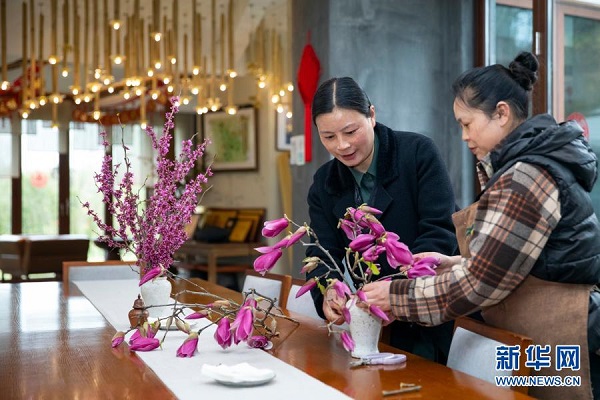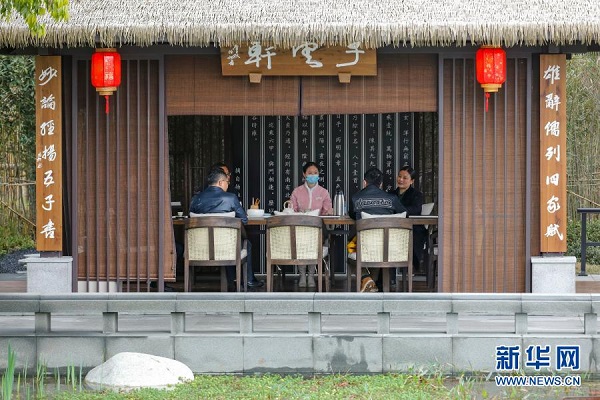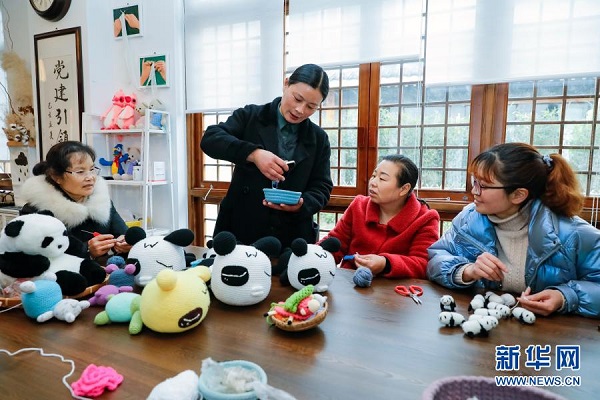Village Official Leads Farmers in Promoting Rural Revitalization
 |
| [Xinhua] |
Shouan, a town in Chengdu, capital of Southwest China's Sichuan Province, is the largest osmanthus-production base in Southwestern China. Due largely to the saturated market, the traditional seedling industry, which used to be one of the pillar industries of Minjiang (a village in Shouan), has suffered from "severe winter" — the depressed market resulted in the stagnation of the seedling trade — during the past decade.
Villagers' well-being has been Tao Xunhua's top concern since 2010, when she was elected secretary of Minjiang's general Party (Communist Party of China) branch. "Our village was in a poor condition a decade ago. For example, its infrastructure was backward. Many women had a hard time finding jobs. Also, given the villagers' lack of awareness about the importance of environmental protection, Minjiang's environment was dreadful," recalls Tao. "Since I married my husband, a resident of Minjiang, dozens of years ago, I have received help from many warmhearted villagers. Therefore, I want to do something to repay them for their care and assistance."
Given the fierce competition in the seedling market, the price of an osmanthus tree fell from more than 3,000 yuan (US $462) to slightly more than 100 yuan (US $15). Tao had a hard time helping villagers sell the trees. In 2015, a university student took home a mini-potted landscape. That gave Tao an idea: Use osmanthus to develop creative cultural products. After discussing her idea with several young villagers, and outstanding entrepreneurs (in Minjiang), who helped villagers escape poverty by developing production, Tao and other village officials decided to help the residents use osmanthus to create cultural, agricultural and sideline products, so they could earn profits. During the past few years, the villagers have developed various osmanthus-related cultural products, including fragrant sachets (filled with osmanthus) and mini-potted landscapes, decorated with small osmanthus trees. The villagers have also created osmanthus wine, osmanthus cakes and other agricultural and sideline products. Young villagers have developed a mobile app, to promote the products' sales. Development of the products has not only contributed greatly to Minjiang's economic development, it has also promoted the local tourism industry.
 |
| [Xinhua] |
Minjiang during the past several years has established several collectively owned companies, which have been dedicated to developing rural tourism. The village has also provided training to villagers, to help them improve their ability to provide homestay services, and/or to serve as baristas (in cafés) or waiters/waitresses. Given their sound development, companies are now able to employ many of the villagers. For example, one company has hired women to create woven dolls (at home), so the company can export the dolls to other countries. Given their efforts to develop production and/or create crafts, the villagers' per capita annual income increased from more than 10,000 yuan (US $1,538), in 2013, to more than 35,000 yuan (US $5,385), in 2020.
 |
| [Xinhua] |
Since she was elected a deputy to the 13th National People's Congress in 2018, Tao has made several proposals to promote rural revitalization. "We will try our best to expand our business. In turn, our villagers can live happy, content lives ... I hope more people (from other regions) will be attracted to Minjiang by its reputation. They will be proud to be Minjiang's villagers, if they settle down in our village," says Tao.
 |
| [Xinhua] |
(Women of China English Monthly March 2022 issue)
Please understand that womenofchina.cn,a non-profit, information-communication website, cannot reach every writer before using articles and images. For copyright issues, please contact us by emailing: website@womenofchina.cn. The articles published and opinions expressed on this website represent the opinions of writers and are not necessarily shared by womenofchina.cn.


 京公网安备 11010102004314号
京公网安备 11010102004314号